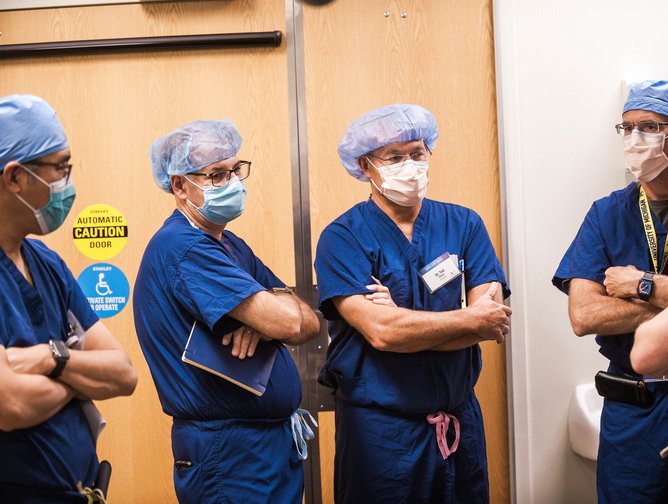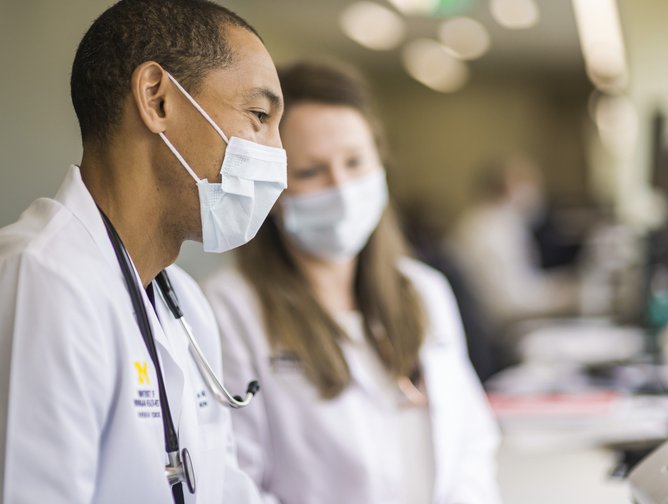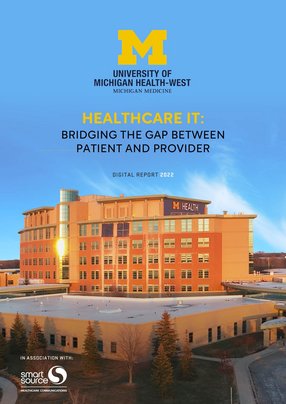Healthcare IT: Bridging the gap between patient and provider
How healthcare providers offer their services has changed. As more services are based outside of traditional bricks and mortar settings - particularly in a post-COVID world - the use of technology is vital to bridge the gap between patient and provider.
Based in the greater Grand Rapids area, the second largest metropolitan area in Michigan, University of Michigan Health-West serves more than 250,000 patients annually. The jewel in its crown is a 208-bed hospital that sits on a healthcare village, where patients are able to connect to multiple different services, including patient-centred medical homes for primary care services across the community.
Over the last 16 years Joshua Wilda, Chief Digital Information Officer for University of Michigan Health-West, has seen the organisation grow and become more strategic as it expands.
“When I first joined, we were the smallest healthcare system in the Grand Rapids area,” Wilda says. “We were up against some very big, nationally-known healthcare systems. And our goal was always to provide choice in the market to drive quality better, to drive care better.”
Having recently affiliated with Michigan Medicine in Ann Arbor, Michigan and rebranded, University of Michigan Health-West is continuing to expand its services.
“We've started to grow as an organisation, not just to provide just basic care models, but now we've grown into a comprehensive stroke centre,” explains Wilda. “We've grown into a centre of excellence for orthopaedics and neurosurgery. We just recently did our first open heart surgery. We never had an open heart programme and now we have that programme.”
With around 20 outpatient centres as well as surgical centres that are providing care in communities, the organisation is rooted in community care.
“Our mindset was always we want to be where the patients are, as opposed to always having the patients come to us,” adds Wilda. “We're a smaller organisation in the healthcare industry, but we do a lot of big things, especially technically. And the only way that we're able to do it is with the intimate family feel that we have within our department.”
Innovations changing healthcare
According to Wilda, the organisation’s vision statement, ‘Our Innovations Change Care and our Care Changes Lives’ shows how it is trying to take advantage of new innovations coming out to change how care is provided.
“How we provide care, different care team models, what are innovative ways that healthcare needs to change and we're providing that to our community,” says Wilda, who describes how healthcare IT is crucial to a healthy relationship between provider - the organisation - and the patient.
“We actually have a strong mission and guiding principles in our IT group,” he says. “We have five pillars of strategy for this organisation. One of them is to be leaders in digital health, meaning that we want to use technology to bridge the gap with patients when they're not able to be here in our four walls.
“When they're in new care settings, like at home, long-term care facilities, even on vacation, how are we using technologies to still embrace our culture, to still bridge that gap between patient and provider?”
“One guiding principle that's near and dear to our hearts is the word techquity, and how our technologies now increase capacity and access to healthcare in all demographics of patients.”
As Wilda explains, technology can enable the automation or streamlining of workflows, allowing healthcare staff to focus on their roles, to provide the highest quality to our patients, rather than on administrative tasks such as data entry.
“Doctors are the highest paid data clerks or medical assistants aren't have their entire attention on patients because they're always entering data or trying to find data,” he adds.
“We're looking at how our technologies either help automate or streamline clinical and business workflows so, as humans, we can spend more time connecting with our patients and with our community. And that's key for us, leveraging the technology to drive that connection as opposed to leveraging technology to reduce connection.”
Benefits of seamless technology
How the organisation manages its digital transformation strategy is critical, to ensure all the areas of the organisation see the same benefits of seamless technology, explains Wilda.
“We want an experience for our patients, providers, all of our customers, to be one that's seamless, one that they don't feel handoffs between technologies in either the care pathways or business pathways,” he comments.
“Platform technologies allow us to even be more interoperable with what we provide. They might not be the best in a single system approach, but the overall experiences are even better for our end users.”
Another key core guiding principle is partnerships with business units and clinical units, Wilda explains.
“We really take strong pride in taking more time in bringing in subject matter experts, within our organisation regarding whatever technologies or problems we’re trying to solve,” he adds.
“We also have a patient advisory council for digital health where we have a subset of our community as a volunteer base. We meet with them on a quarterly basis. We show them our technical roadmap, we talk to them about the solutions that we're coming up with, and they help us understand what they want to see, what they like in other industries, and if we can bring them to this market.
“I think IT is more about people and connections than it is about technology, so that's where our strategy really lies in how we deliver that to this organisation.”
New potential technologies
When selecting new technologies it’s important to keep it simple, and not to innovate for the sake of innovation, Wilda adds. “We really want to keep it as simple as asking, what are our must-haves,” he explains.
“You can get caught in that wheel of innovation where you innovate just for innovation's sake,” Wilda points out. “Does it really make sense for the organisation and is it scalable?”
“We partner with the actual users of the systems in picking and choosing what's best for them. It has created a very good relationship in our organisation that they accept innovation because they're at that table.”
Together with Smart Source and Tavoca, University of Michigan Health-West worked to build a platform allowing improved communication with patients, through voice, text and email.
“Tavoca was a perfect example of, in this day and age, how we communicate with patients when they're not within our four walls. It was right before Covid that we had a system that sent out reminder calls to patients about their appointments. But that's all it was: it was just one call and that was it.
“We didn't have a good platform to understand where patients accept those calls, give patients the ability to cancel or reschedule or interact with the system,” he describes. “We also know that patients like to be communicated with differently, whether it’s texting, email or by phone. It allowed us to add a personal touch to the communications, ensuring that our high-touch, personal culture came through within the technology.
“So when we were out looking for a new platform that was scalable, that we could do a lot more things with, we found Tavoca, one that was deeply rooted in a partnership relationship, wanting to understand how healthcare was changing, and how they can continue to innovate.”
The implementation helped reduce the hospital’s no-show rate - which had been between 10 and 12% - dramatically, Wilda says.
“Implementing Tavoca and the different platforms that they're able to provide to us, we actually dropped our no-show rate by 5% within the first three to five months of using that system,” he adds. “And it's stayed at steady levels which showed us that, again, it's not just communicating, it's the way you communicate that impacts the patient best.”
And through Smart Source, the reselling vendor of Tavoca, the organisation is looking at other solutions to boost patients’ experiences such as call centre technologies.
“We are looking at Smart Source to potentially provide us with other solutions that they know will integrate all together, to meet that experience,” adds Wilda. “It feels, it talks to you in the same language, it has those integrations.”
Expanding the right type of care
In a post-pandemic world, where patients are increasingly treated outside of the hospital’s ‘bricks and mortar’ setting, the organisation is looking at expanding how it offers care with the right technologies.
“COVID really has opened the door to laggards in the healthcare industry that said you had to be in the hospital to be treated,” comments Wilda. “COVID saw that patients, their diseases, they didn't wait for the pandemic to be over. So we had to expand how we treated patients in their homes, in family and loved ones' homes: different care settings that might not have been our own. So for the next 12 to 18 months, we're really looking at expanding the right type of care and the right setting with the right technologies.”
It is easy to focus on the clinical side of healthcare IT, but the use of technology has many other uses, as Wilda describes.
“Helping the HR department, where there's an initiative that we're talking about, how do we help you get through your resumes?” he says. “How do we make sure the right candidates are getting in front of you? Because if you fill a role quickly with the best applicants, then you're providing even better patient care.
“How can we help facilities manage our organisation better? Because quite frankly, when patients walk in our four walls, the first thing they see is the four walls. They don't see the doctor. And so if things aren't crafted well or aren't being managed well, or are not automated well, patients will treat that as a quality issue.
AI to be a future trend
Already showing its benefits, the use of technology will only increase in future - from utilising artificial intelligence (AI) and machine learning to increased use of automation and the use of robot process automation (RPA).
“One thing that we are really innovating here at University of Michigan Health-West is using voice, and ambient speech and conversational natural language speaking products and services to really drive care,” Wilda explains.
“We have a mindset that when all this technology fails, we rely on voice, we rely on calling, we rely on talking. How can we automate and how can we capture, through some of these ambient technologies, the use of voice to streamline our work and keep digital intimacy with our patients?
“One of those we're using is a product called DAX which is Documentation, Ambient Experience from Nuance. It allows us to have a conversation about healthcare: there are no longer computers in the way.
“You use the computer to augment the education, but no longer is the provider sitting there typing. It actually captures that whole conversation, digitises it, understands what is relevant from a medical perspective, and then puts that in as the note for the provider. So the provider no longer has the cognitive burden of typing that all out. Now they can focus on the patient, they review the information later on and edit if needed and accept it.”
A key use of technology in the future, Wilda says, will be the automation of a lot of functions that put the data-capturing burden on individuals.
“How can we automate those things so we can spend more time with patients and providers?,” he concludes.
“I think right now there is that scepticism of what is governance, our innate human desire for job security. You know, we hear this a lot. ‘You're gonna use artificial intelligence to end my career as a doctor’.
“No, it's to build artificial intelligence to provide you insights. So your human sentient being of caring can really be maximised when it needs to be with called out insights to key pieces of information using AI,” he concludes. “And, then how can we embed those insights in the user's workflows so it feels natural and easy to access?
“It is more so about embedding it in the workflow so it feels more natural. So the care with patients feels more natural. So I think that in the next, at least 18 months, you're gonna see this big uptick in the use of artificial intelligence in the healthcare industry.”






